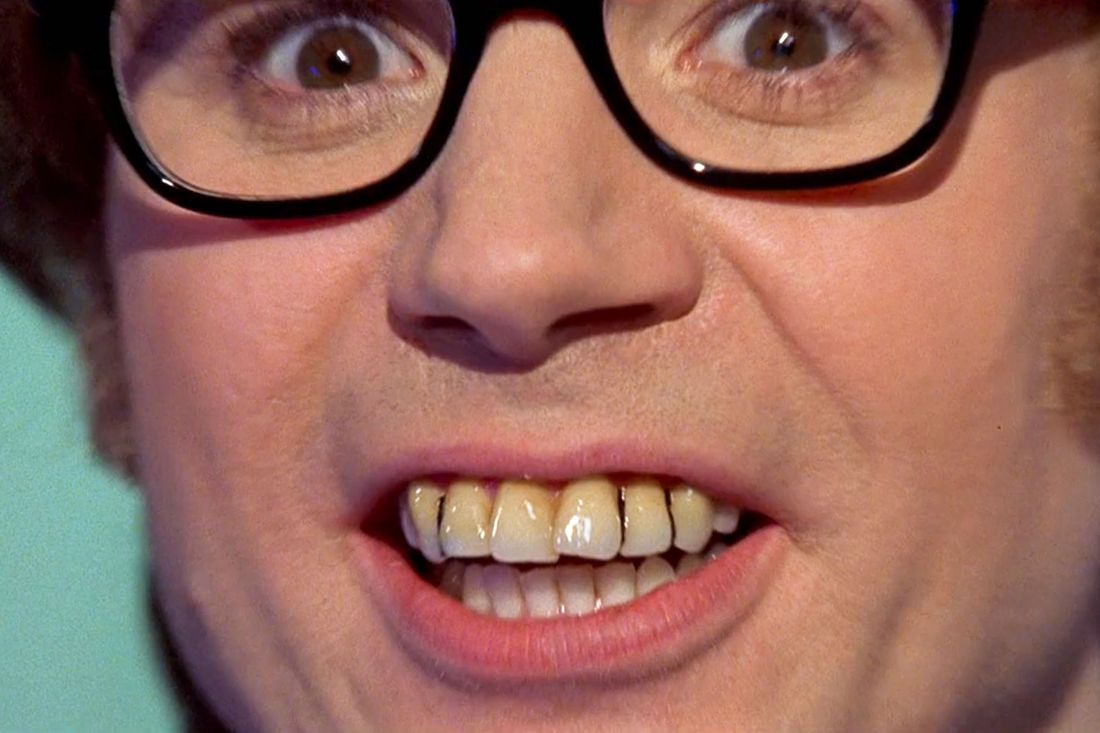
As a longtime fan of the Austin Powers trilogy, I find it fascinating to delve into the details behind the creation of such iconic characters. Gary Archer, the man responsible for Austin Powers’ infamous teeth, has undeniably left an indelible mark on pop culture. His work is a testament to the power of subtle yet impactful character design, and I can’t help but marvel at how a simple set of dentures could transform a character into an unforgettable icon.
Working on an actor’s teeth for a TV or film production, as explained by Tony Gardner from Alterian, Inc., the special effects studio, is similar to performing a magic trick. Whether it’s large physical teeth or a comical gag, each set of teeth needs a touch of sleight-of-hand to make viewers believe what they see in an actor’s mouth is genuine. As Gardner notes, when working on someone with a recognizable face, any deviation from their normal appearance can be noticed. For instance, if the person turns sideways and their mouth appears more like a snout due to the need to close their lips over the teeth, it’s obvious something isn’t right. Achieving a seamless result requires great attention to detail, and the process is complex for the dental technicians and prosthetics specialists who design the appearance of tops, bottoms, individual teeth, fangs, and other designs; create molds from 3D models of the actor’s mouth; take impressions and measurements; cast, sculpt, shape, and paint the false teeth and gums; and finally, make any necessary adjustments to ensure a perfect fit.
In the realm of dental technology, several methods employed in creating retainers, braces, dentures, and even items like Invisalign or mouth guards are similar, which is why professionals in this field undergo specialized training. For instance, components made using vacuum-formed plastic, often termed ‘vacu-forms’ by experts, resemble Invisalign or mouth guards. Since these designs enter the intricate oral environments of actors and stuntworkers, the materials used – acrylics, paints, and others – must be approved by the American Dental Association to ensure they don’t cause harm. If too tight, these pieces could potentially damage the mouth or even break teeth, as dental technician Gary Archer has witnessed with metal grills. Conversely, if they’re too loose, the teeth might impede an actor’s speech or draw undue attention to their mouth. Despite the need for meticulous precision in terms of spacing, size, length, and density, this process also offers a creative and effective means to alter someone’s appearance. As Chris Lyons, director and owner of special-effects company Fangs FX, puts it, “Every mouth is unique. Every face is different. Everything is individual. You have to consider everything.
To gain insights into the creation processes behind some of cinema’s most iconic tooth designs across various genres in films and television, ten dental designers, makeup artists, and showrunners have revealed their secrets. Their tales encompass a wide spectrum, from acquiring large quantities of K-Y Jelly to enhance an alien queen’s tusks, to a villainous Bond character donning two sets of fake teeth simultaneously.
30 Days of Night
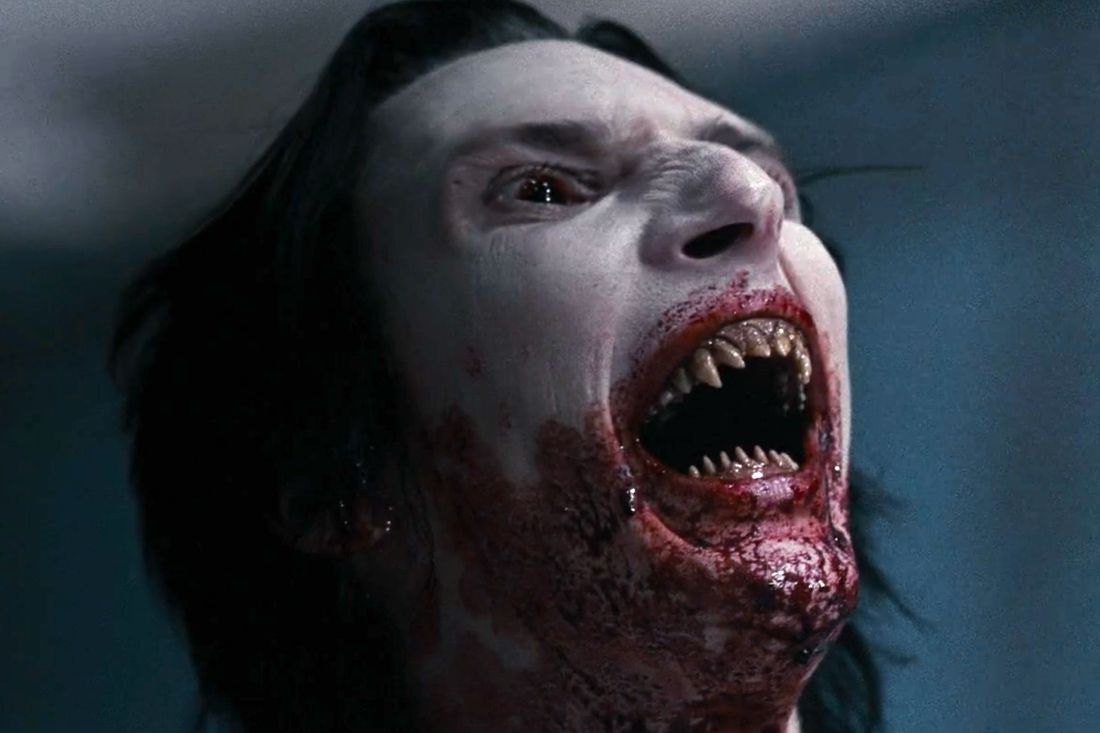
Vampires have existed on film for nearly as long as film itself. The Wētā Workshop team, including special makeup-effects supervisor Gino Acevedo (whose creature-feature credits include teeth for the one-sixth–scale Godzilla used in Roland Emmerich’s 1998 film) and on-set prosthetics technician Gareth Jensen, were tasked by director David Slade to reinvent what a vampire’s fangs look like. The result was about 70 pairs of irregular, jagged teeth.
Gino Acevedo stated that during their meetings with David, he expressed a desire for the vampires to be distinct from typical ones, without the conventional fangs. Instead, he wanted them to have shark-like teeth for biting, tearing, and ripping flesh. The process began by taking impressions of the actor’s teeth, followed by making molds, creating a clear vacu-form, sculpting changes with clay, making more molds, pouring in dental acrylic (the material used to make dentures), and finally painting them up.
Occasionally, we’d find ourselves dealing with tiny air pockets on our modeled teeth, which were quite bothersome. Despite attempts to mend them, they would always appear slightly discolored and less durable than the original. We worked tirelessly on countless sets of teeth, both upper and lower. It took us nearly a month to shape each set and apply the paint. The color scheme was intentionally designed to make them look extremely decayed and grotesque, as if they belonged to a carnivore with excessive consumption. Instead of a vibrant pink, we opted for a dull, faded pink for the gums to reflect their poor health.
Gareth Jensen: Special paints are used for dental monomers, resembling watercolors that can be applied layer by layer. Initially, the dental monomer appears extremely white, but it takes depth when colored and shaped. The sculpt is accentuated to make it stand out on camera. This process involves intricate detailing with small brushes and delicate work.
In this scenario, we adjust the prosthetic teeth to fit each actor precisely. Some edges might be slightly sharp, so we smooth them out. One actor was missing a front tooth, which we took into account when designing his character. We make two sets for every actor, with a spare set as a backup in case of damage. We warn the actors to be cautious while getting accustomed to their teeth to avoid biting their lips or tongues, as they could cause injury. Unfortunately, a few people did accidentally bite themselves, but that’s just how it goes sometimes.
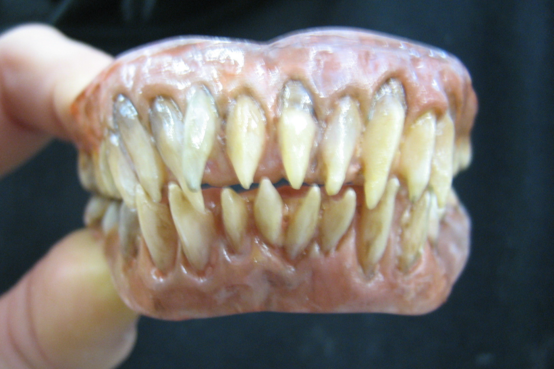
Fortunately, only a few actors needed to recite lines in this production. On-camera, they appeared truly terrifying, yet their teeth seemed somewhat ludicrous since they struggled to keep them shut. There was constant adjustment of the teeth and inspection, ensuring that each pair was correctly placed, preventing any mischief such as attempting to sip coffee through them. The stunt performers would occasionally toss the teeth at me, saying, “I’m finished. Here you go.” [Laughs.]
In our production, we employed Karo syrup as a substitute for real blood, similar to corn syrup. This method is reminiscent of an approach used in “Lord of the Rings” for orc makeup. We added green and black food coloring to Listerine, which the actors would drink, swish around their mouths, and then spit out. This process stained the insides of their mouths with a revolting color.
The initial appearance of all of them – the collective arrival of the vampires, each showing their sharp teeth – was a moment of great pride. Seeing everyone gather on-screen makes you think, “Wow, you guys are truly terrifying. You’re an endearing bunch, dripping in blood and bearing fangs.” (Paraphrased)
Hellraiser (2022)
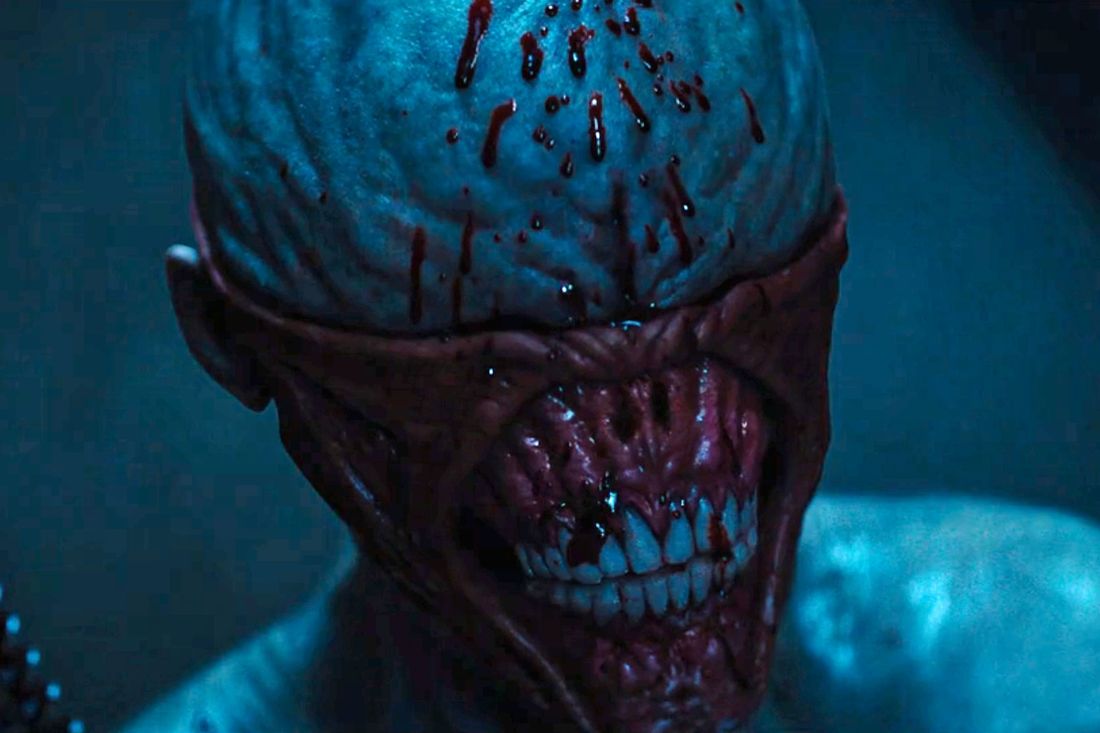
In 1987, Clive Barker’s movie titled Hellraiser marked the birth of a horror franchise filled with gruesome and twisted violence. Artisans like Robert Keen and Simon Sayce played crucial roles in bringing this world of the Cenobites and their intriguing blend of pain and pleasure through sex, to life. The 2022 reboot, which revisited this universe, aimed to satisfy longtime fans while still offering something fresh. Josh and Sierra Russell from Russell FX, who had previously collaborated with director David Bruckner on his horror films The Ritual and The Night House, were responsible for designing 15 Cenobite costumes for the film. The iconic Chatterer character presented a chance to seamlessly blend the old and the new.
Josh Russell: The initial designs were created by lead concept designer Keith Thompson and David Bruckner, who had already been developing them before our team joined in. As a fan of the original and someone who appreciates the delicate balance needed when remaking horror films, we felt that without the right director to guide it, we might not have taken on this project.
In the remake, only Pinhead and The Chatterer were the surviving legacy characters. It’s crucial not to botch it as fans eagerly anticipate and support it. We brought on Jason Liles, who was the initial Cenobite cast member to join us. Our first crew hire was Mike Rotella, the sculptor, who began working on The Chatterer.
Initially, our initial concept featured a sleek, round-headed design with an emphasis on making the character more monstrous, longer and elongated horse-like teeth, exposed gums pulled back significantly, and a peculiar opening in the forehead. [Laughs.] Upon showing it to our director, he expressed some concern and went home to reconsider. Returning the next day, he agreed that a monster was indeed needed for this monster movie. We found a middle ground, scaling back the teeth from their original size to about a third, blending them into the sculpture, and casting all in silicone rubber. The skull is made of fiberglass and motor-operated, opening and closing the mouth. It’s quite rewarding to hear it in action on set. We chose an animatronic design to avoid dealing with fixing chipped teeth for eight weeks during filming in Serbia. We later created a partial version with hard teeth for quick insert shots of just the teeth.
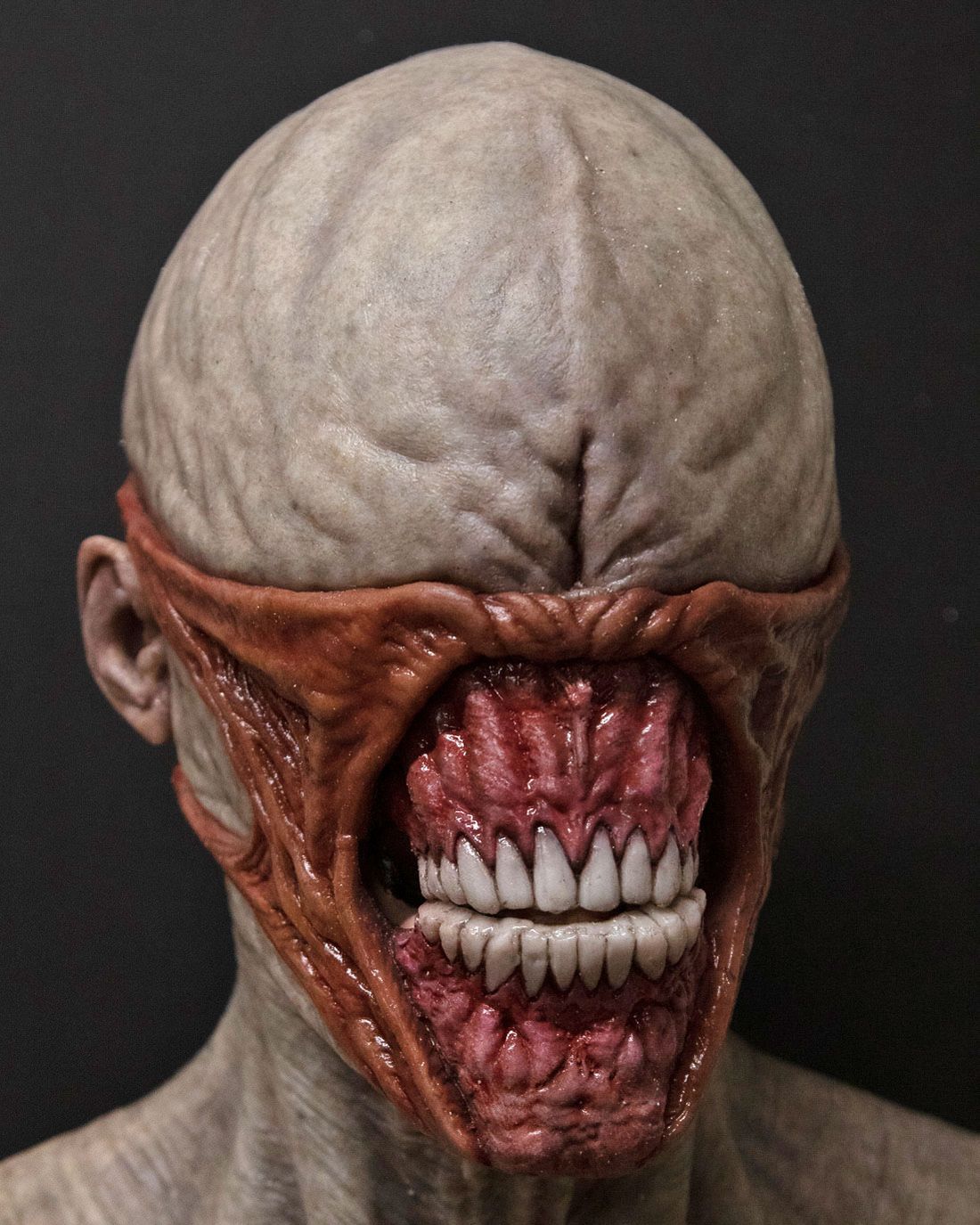
Given the large size and unique design of the costume, a set of dentures would have been minuscule compared to the rest, or wearing such a large Walking Dead-style denture prosthetic would have been uncomfortable for the actor, resembling a duckbill protruding from their mouth. The character’s limited motion also makes it easier to operate the dentures remotely rather than having an actor move his jaw all day. We aimed to make those teeth bite forcefully. The entire headpiece is one continuous piece that fastens at the back with a zipper, and it attaches to the rest of the costume at the shoulder bust. After putting on the helmet with the animatronic controls, you put on the silicone skin, which stretches over the entire piece.
Sierra Russell: We needed to loosen the mask a bit for Jason to ensure it felt as comfy as feasible.
Each time the mask was worn, it would subtly adjust its fit and impact the movement of the teeth, which was crucial for the character. On one particular night in the woods, the teeth mechanism malfunctioned, causing distress among the producers. One of them exclaimed, “This is a key scene for The Chatterer! What are we going to do?” [Both laugh.] We managed to fix it, and the result was fantastic. It’s one of the best scenes featuring The Chatterer; it occurs before his death. This has been our most entertaining experience working with teeth.
S.R.: He’s the toothiest we’ve done, for sure.
Girls5eva
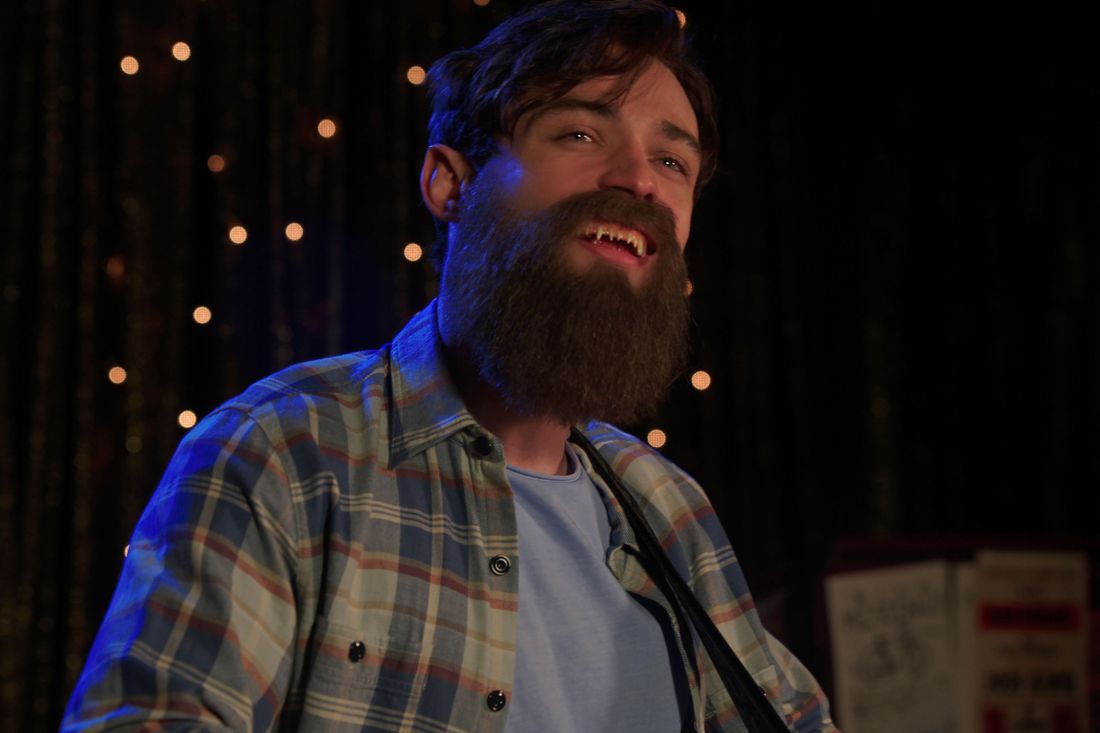
In the quirky universe of Meredith Scardino’s series ‘Girls5eva’, anything can happen: a girl band experiencing a comeback after being out of touch for decades, a cafeteria machine transforming an entire chicken into tasty nuggets, and a dentist-to-fox tooth transplant performed by Gloria, one of the band members and a dentist, to help her friend Gray Holland, a globally famous pop star, fake his death, escape stardom, and begin a new life as an unsettling performer at off-the-beaten-path open mics. As makeup supervisor La Sonya Gunter explains, “Thomas is breathtakingly beautiful, but when he puts those teeth in his mouth, it’s a truly memorable scene.
Meredith Scardino: When Paula discovers that Gray is actually feeling confined, does she support her friend in this situation? Initially, we considered the most drastic approach – helping him out. However, we then decided to write a scene where Grey Holland is contentedly living undercover with some fox teeth. We asked La Sonya for advice, explaining that Thomas Doherty has an appealing set of teeth. Our question was, “How can we make it seem like he has these small, irregular, spaced-out fox teeth?” After that, she started working on it.
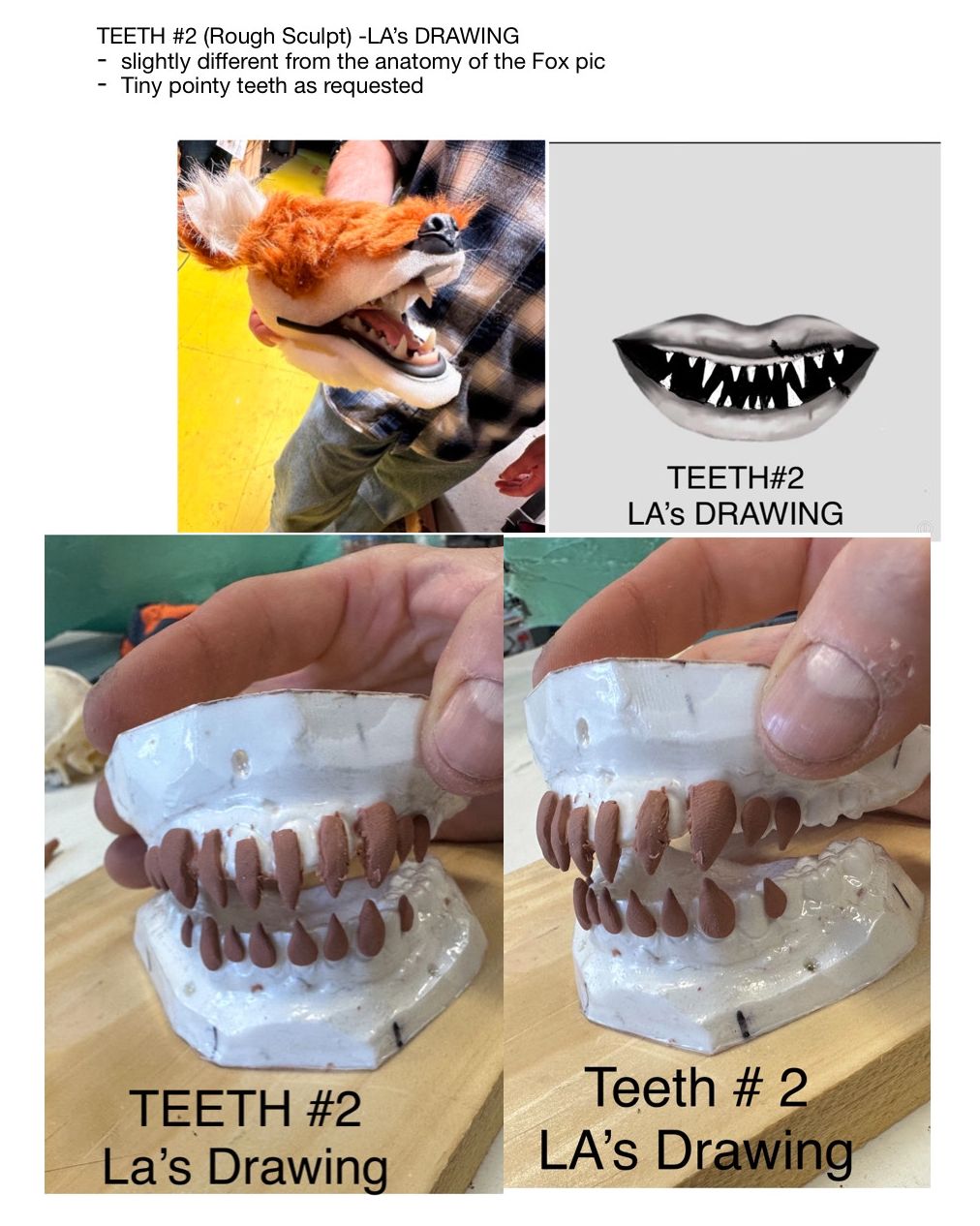
Sonya Gunter: I’m designing some sketches, and they have a B-movie, sharp, spooky tooth vibe going on. My initial sketch was hand-drawn, resembling Halloween teeth. I continued sending Meredith these sketches, and she returned the favor by sending me her own sketches too.
Instead of using a live fox, Paula prioritized humane treatment and opted for a puppeteer to create a fox puppet. The teeth we adjusted were those from the puppet, though they had a Muppet-like quality, so we crafted the ones in Thomas’s mouth to resemble tiny, sharp demon daggers.
I visited an exceptional special-effects makeup artist named Jason Milani to get some unique sculptures made. He worked closely with Thomas, creating a mold using alginate. Once they finished the mold, he crafted it from acrylic. The process was similar to a dental appointment, but instead of getting fox teeth, I was getting prosthetic ones. He applied dental paint to the teeth, and within about two days, they were ready. In fact, during a break, I even ran outside to snatch the teeth before he could finish installing them in the car.
M.S.: He couldn’t stop! He threw them out the window. [Laughs.]
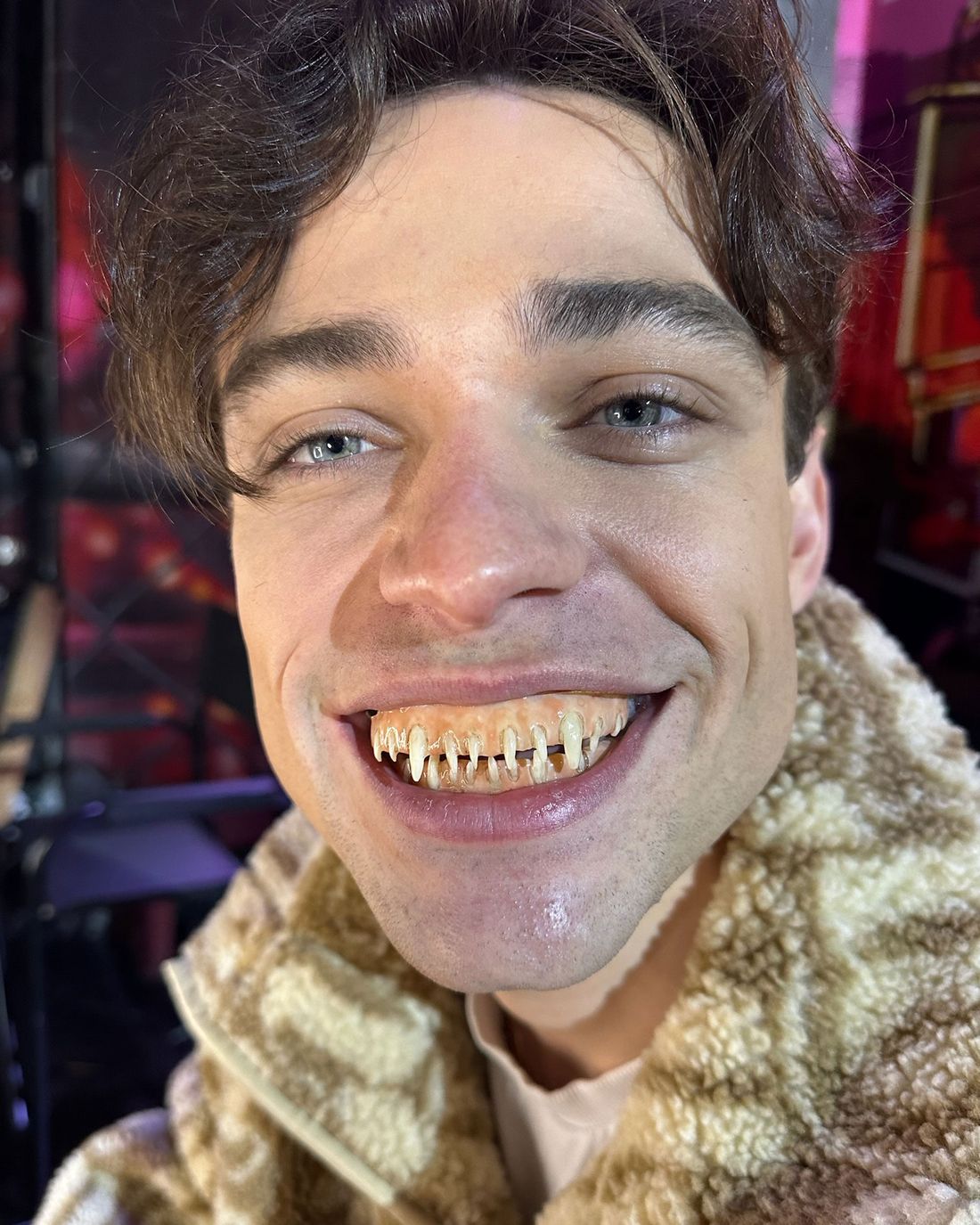
Thomas put them on for a test fit, and we slightly adjusted them. We brightened the gum area a bit. Since the teeth were crafted from acrylic, I was able to employ Skin Illustrator, which serves as a color palette, primarily used to camouflage tattoos.
M.S.: Everything had to be shaved down and spaced. I think we elongated the canines.
In the process of doing it that day, I found myself exclaiming, “These aren’t small enough!” So, I grabbed a file and began to smooth and sharpen them. I made them sharp-pointed. They were so fragile, and I had to handle them carefully, but at the same time, I was also thinking, “I need to file them down just a bit more!” It turned out to be quite enjoyable.
As the day drew to a close, our schedule was brimming with activities, almost an afterthought labeled “as time allows.” We attempted a few scenes, and he truly shone in each one. Before revealing those brilliant teeth of his, he had a couple of lines to deliver first. It was more amusing to jump straight to it, and there he was, one of the most captivating individuals I’ve ever met, showcasing those stunning teeth. He was an absolute delight to work with, always ready for anything. And on his final day, we surprised him with a cake adorned with a fox – a fitting farewell for such a remarkable guest star.
There’s Something About Mary
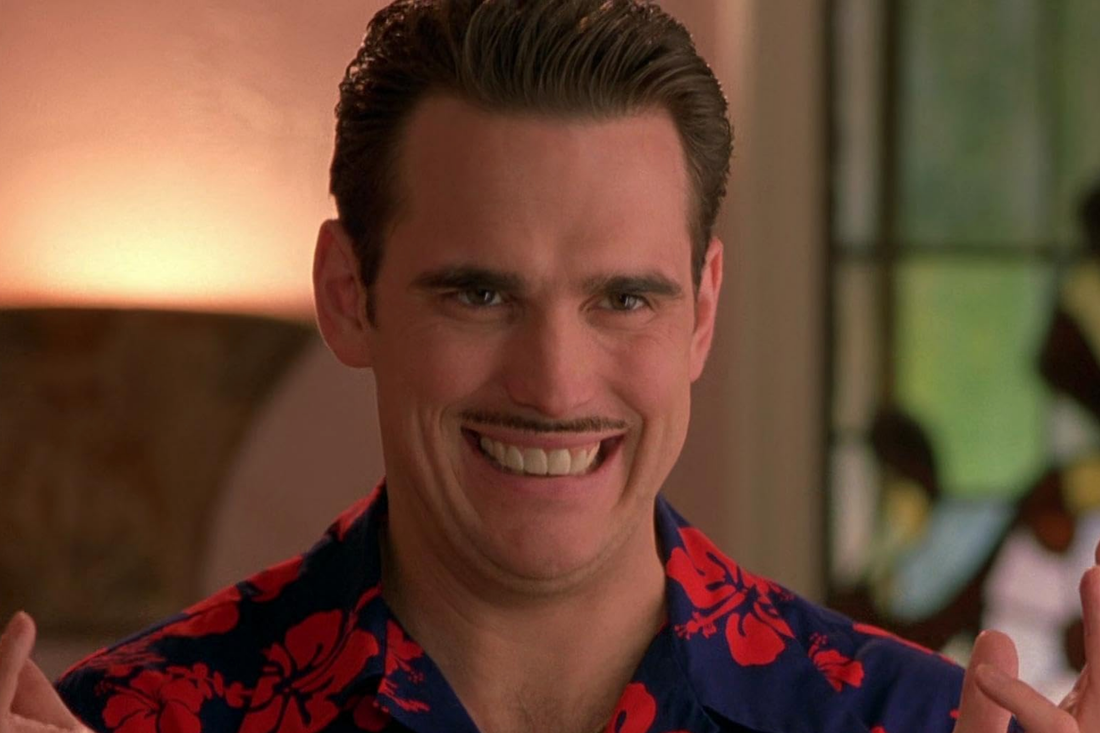
In the days prior to excessive glamorization in Hollywood, the movie “There’s Something About Mary” popularized the idea of teeth that were slightly oversized and impeccably perfect among typical comedy audiences. In an attempt to charm Cameron Diaz’s character Mary, the private investigator Pat Healy (played by Matt Dillon), misinterprets a compliment about another man’s teeth overheard during a conversation: “The larger, the better… There’s nothing sexier than a mouthful of pearly whites.” He believed his capped teeth would impress her, a belief that Tony Gardner, special effects supervisor at Alterian, Inc., had to convey convincingly with a set of disconcerting veneers.
Following my review of the script, I found myself outside my house, away from my children’s ears, as I probed Peter and Bobby Farrelly about their specific expectations for various aspects of the film. They delved into topics like saggy old lady breasts and dogs being set alight, but they also hinted that Matt Dillon’s character would attempt to charm Cameron Diaz and enhance his appearance, as he saw it, in a manner similar to Tony Robbins’ confidence and authority. Peter compared this transformation to a person aiming to replicate the self-assuredness and dominance of Tony Robbins. Despite Robbins being a large man with large hands, a large head, and big teeth, Matt Dillon’s character, who was pursuing Mary, would interpret this literally on a smaller scale. This meant his teeth would be exaggerated yet flawless, gleaming white. However, balance was crucial, as the lower teeth also mattered because they affected pronunciation. Matt would need to wear these oversized but perfect teeth for most of the movie, presenting a learning curve and a challenge for him.
To determine the ideal size, we created three versions, but it was a delicate task since we could easily veer towards a overly-cartoonish appearance, similar to Jim Carrey in “The Mask”. The subtle differences between these versions had only minimal impact. We crafted the largest of the trio on molds of his teeth and could manipulate it on an articulator to open and close, showcasing its cartoony nature. This experience led us to favor a more realistic approach. My takeaway is that you must continually reduce and tone down the amount of additional material added to the actor to reach your desired effect. Peter put it as finding “the thin line where you’re straddling reality and parody, just nudge it slightly towards parody and observe what results.
When crafting dental pieces or props for an actor, it’s a collaborative endeavor. It’s essential to ensure that the creation harmonizes with their unique features, such as the breadth of their nose and the distance between their eyes. We jointly conceive half the concept, while it falls on the actor to bring it to life and make it feel authentic. Matt excelled in this task, demonstrating exceptional skill. The dental work in question was merely an upper veneer that encircled the front, extending as far as possible on the sides without pushing his face upward due to his prominent cheekbones. All teeth and gums used were artificial. His primary worry was the fit and durability of the pieces during intense facial expressions. To help him get accustomed to them, we provided a pink set as a trial run, made from the same material acrylic gums are cast in, since it was meant for practice and could be discarded easily. He often wore them without realizing, even flashing a smile at people, which apparently created quite an unexpected impression. [Laughs.]
Folks often bring it up to me. They believed that Matt truly underwent porcelain veneers, finding it amusing. The idea that they consider his transformation as genuine is the highest praise one could receive.
Aliens and Alien: Romulus
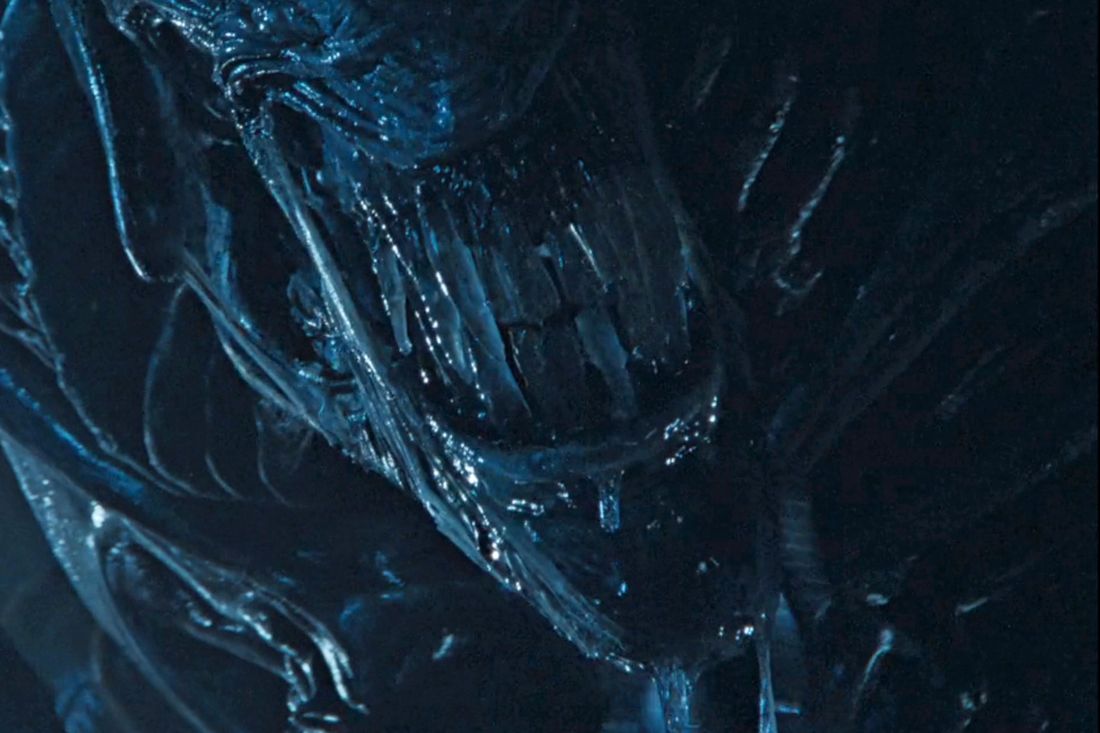
The xenomorph instills a considerable degree of terror due to its extreme features. Its elongated form, spindly digits, acidic blood, and not one but two mouths filled with razor-sharp teeth make it particularly frightening. Introduced in the movie Alien by Ridley Scott, the concept seemed impossible to make more terrifying – until Aliens revealed the alien queen. Shane Mahan, who was the coordinator of creature effects and sculpted the alien queen’s head at the time, stated that they took their role very seriously, aiming to do justice to the idea and make Stan Winston proud, given the immense responsibility. As he put it, “We aimed to make it as menacing-looking as possible.” Working with the legendary Stan Winston Studios, Mahan was involved in other projects such as The Terminator and Interview With the Vampire. Later, as a co-founder of Legacy Effects, Mahan has designed prosthetics, makeup, and various effects for numerous films like Iron Man, The Shape of Water, and Alien: Romulus, revisiting the franchise once more.
Shane Mahan: We were part of the team that worked on “The Terminator,” which was the initial collaboration between Stan Winston, myself, James Cameron (who was both writing and directing), John Rosengrant, Tom Woodruff, and Richard Landon. This project laid the foundation for a long-lasting artistic group led by Stan Winston, and it also fostered a strong relationship between Stan and James Cameron.
The issue of the teeth was a very strong consideration, because we were such fans of H.R. Giger’s work and Ridley Scott’s first Alien xenomorph creature, which had silver metallic teeth. Jim and Stan were of the opinion of creating their own iconic vision, and they didn’t necessarily want metallic teeth on the queen because they were so large. Her teeth were about four, five inches long in some cases, and they just felt like it would be too glaring and not organic enough. There were certain areas of it that were translucent — I was striving for a lot of translucency on her face anyway — but certain materials weren’t available back then to make the skin translucent. So it was deemed to make her teeth a hard, clear urethane, much more like a deep-sea fish, and I think it was the right choice.
Previously, we used rough drawings of the queen and a small-scale model as guides. These sketches, made by Stan and Jim, served as our initial references. We then scaled down our sculpting project to a quarter size replica of the queen. I was tasked with creating the queen’s head over an eight-week period, while other artists worked on different parts of her body. At that time, this was one of the most substantial creatures for visual effects that had been completed.
I would mock up teeth out of a plasticine, mold them, cast them in plaster, polish them down, and then insert them into the WED clay so that they wouldn’t dry out and they would sustain the weeks of time. They were remolded into clear urethane, inserted into her fiberglass understructure, and painted. There were probably three, possibly four, heads made, and dozens and dozens and dozens of teeth. The saliva was a food additive called methylcellulose. It’s added to other things that thicken things up. Also, we used tons of K-Y Jelly. I think we bought every bottle of the stuff in the Windsor, U.K., area for months at a time, from every pharmacy. It was always a fun thing to go buy 100 bottles of K-Y from the local pharmacy.
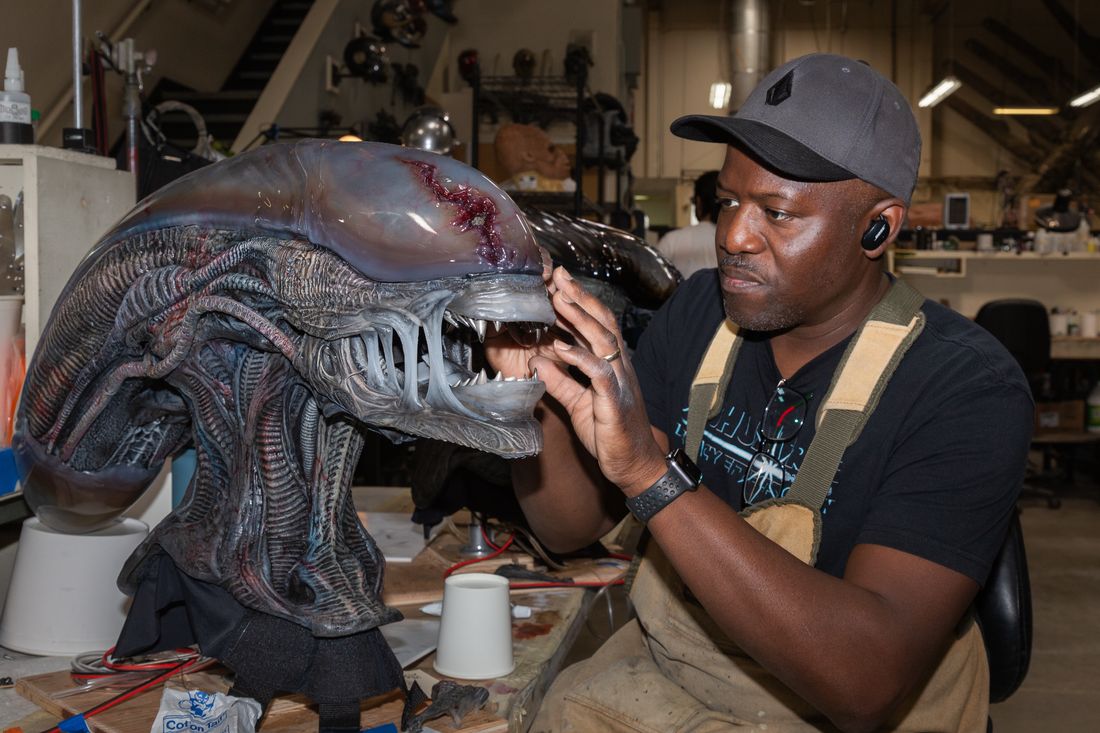
The queen’s tongue, approximately four feet in length, could be extended using a pulley system mechanism. This extension was manually controlled, requiring great care to avoid injuring Sigourney Weaver. Pushing too hard might damage the teeth inside, which would cause problems during filming. The mouth had to be opened first, then shot out and closed again. Interestingly, the inner mouth also had its own opening mechanism. However, the teeth weren’t made of translucent acrylic as one might expect. Instead, they were cast in a different type of opaque acrylic, which seemed unnecessary. It would have been better if they had used clear acrylic to maintain the intended visual effect. This discrepancy seems to be unintentional.
I recall an intriguing lesson I picked up. Once, I had a Polaroid image of the queen, planning to share an updated version with Jim during filming. I jokingly asked Sigourney, “Hey, would you like to see the queen? I have her picture,” and she declined, preferring to keep her reaction genuine on set. I felt a bit silly for asking, but it made me realize, “That’s exactly right because that’s how you create authenticity.” It’s essential for her intense fighting scenes, with teeth snapping and growling, to elicit such immediate and visceral reactions. This same principle applied on our latest production as well.
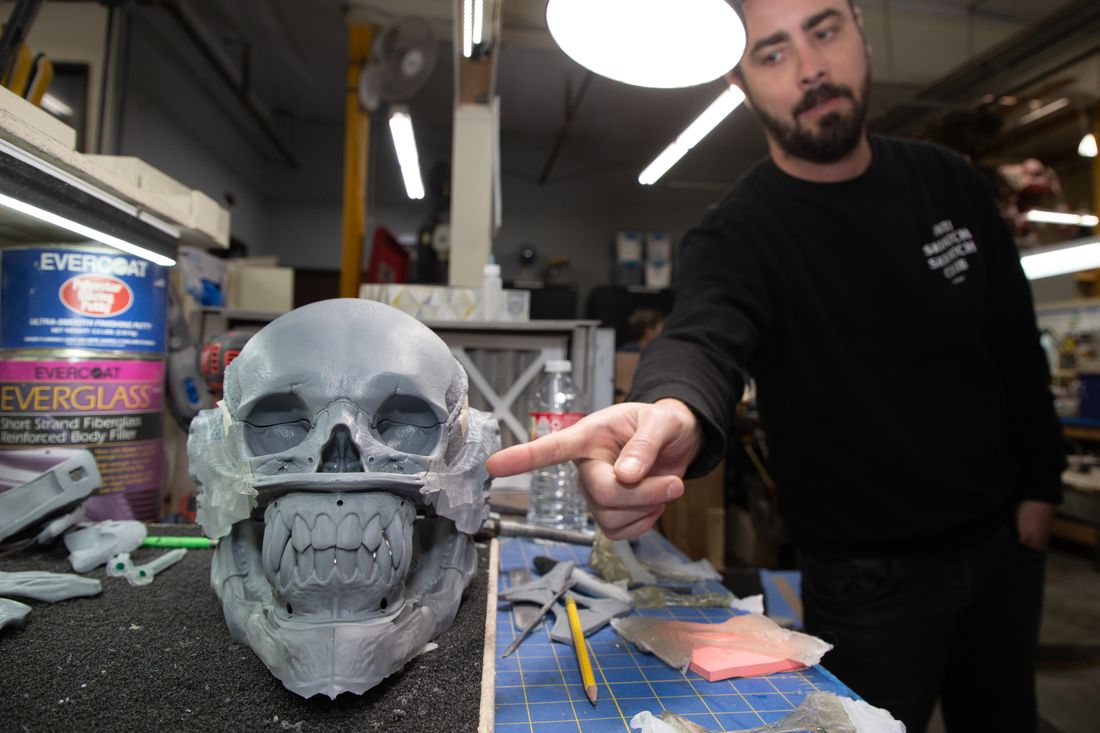
In a shocking turn of events for us at Legacy, Romulus, an Alien film, connects with Aliens. I never imagined we’d be involved in another Alien project. The unusual aspect of Romulus was that the special effects work was shared among three different FX companies. Director Fede Álvarez assigned us the task of designing the xenomorph, the cocoon, the birthing scene, the Offspring, and the Rook character. Our updated xenomorphs no longer have transparent teeth; they’re now metallic, large, sharp, and incredibly ferocious. The interior mouth was also revised and it wasn’t enamel colored this time, but silver. These specific details are stored away in my memory as potential areas for improvement should we get a chance to revisit certain aspects of the project.
The hybrid character originally designed by The Offspring was intended to be a character with prosthetic makeup rather than a robotic creature. Initially, it was planned to portray a small child, but it evolved into the role of Robert Bobroczkyi, an exceptional actor discovered by Fede. Every day, various sections of prosthetics such as silicone chest and back pieces, head and face parts, neck, hands and elbows, and legs are attached to his body using adhesive. This includes around thirteen distinct pieces that are then detailed with body paint. He wears a set of veneer teeth for the makeup, which aren’t human teeth since they would detract from the overall creative design. Instead, there are various sets of acrylic and vacu-form teeth molded to fit his mouth comfortably. These are made in multiple sets as a precaution, in case they break or get lost during filming. Such incidents can occur frequently.
Skyfall
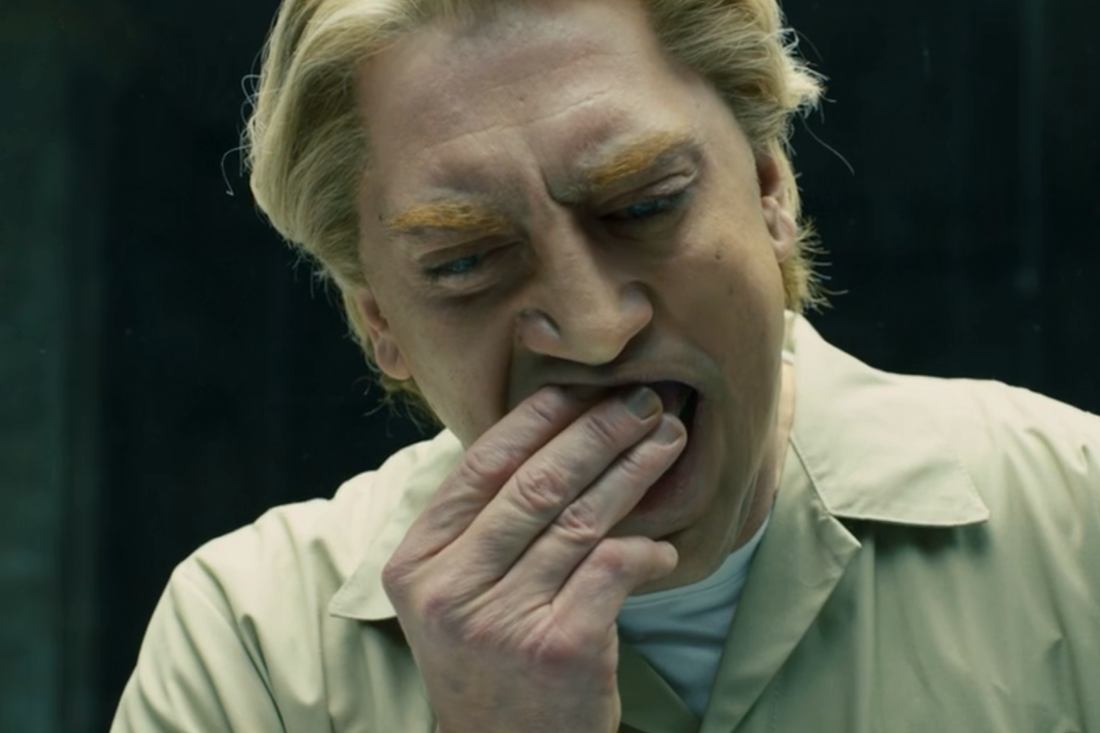
It takes a memorable image to overshadow Javier Bardem flirting with Daniel Craig in Skyfall, but Bardem revealing a set of horribly decayed-by-cyanide teeth just about does it. Chris Lyons, director and owner of Fangs FX, made three teeth tops for Bardem’s villainous Raoul Silva, including rotten teeth that hid underneath the character’s veneers. Stacking two pieces on top of each other was a “one-off” that Lyons hadn’t done before and hasn’t done since.
Chris Lyons: Naomi Dunn, the makeup designer, called me with exciting news: we’ve been selected for the Bond film project – my first time working on a Bond movie! They created a visual effects prototype, which depicted Javier Bardem removing his teeth and collapsing his face in, leaving behind decayed ones. Interestingly, throughout the film, Javier wore our teeth, and in one iconic scene, he donned two sets of teeth at once – one stacked over the other. In that scene, he removes the healthy teeth to reveal the rotten ones. Additionally, he held a prop resembling a jawbone, made of metal, which was later digitally enhanced to make his face appear caved in. Regrettably, during this process, they softened the appearance of the dirty, broken, decayed teeth as well. The task of inserting two sets of teeth into Javier’s head without distorting his facial expressions and allowing him to speak was quite challenging. It was a unique experience, but Javier was more than ready for it.
As an avid fan, I must admit, even we were taken aback by the extent of his dental issues, but they weren’t as severe as it seemed at first glance. The thinnest layer of decay on his teeth was barely a millimeter thick. The replacement set covering them was roughly two millimeters thick. Interestingly, the good pair he usually wears is around 2.5 to 3 millimeters in thickness. Once we managed to craft the ideal set from that durable material, our challenge then became ensuring both sets fell within that thickness range.
I’ve watched all of Harry Potter, Indiana Jones, Star Wars, Game of Thrones, House of the Dragon, and Doctor Who. However, it was always Bond that seemed out of reach for me. But luckily, I got to do the last two Bonds as well! So, I’m extremely thrilled, and even the prop ended up in the Bond archive.
The Righteous Gemstones
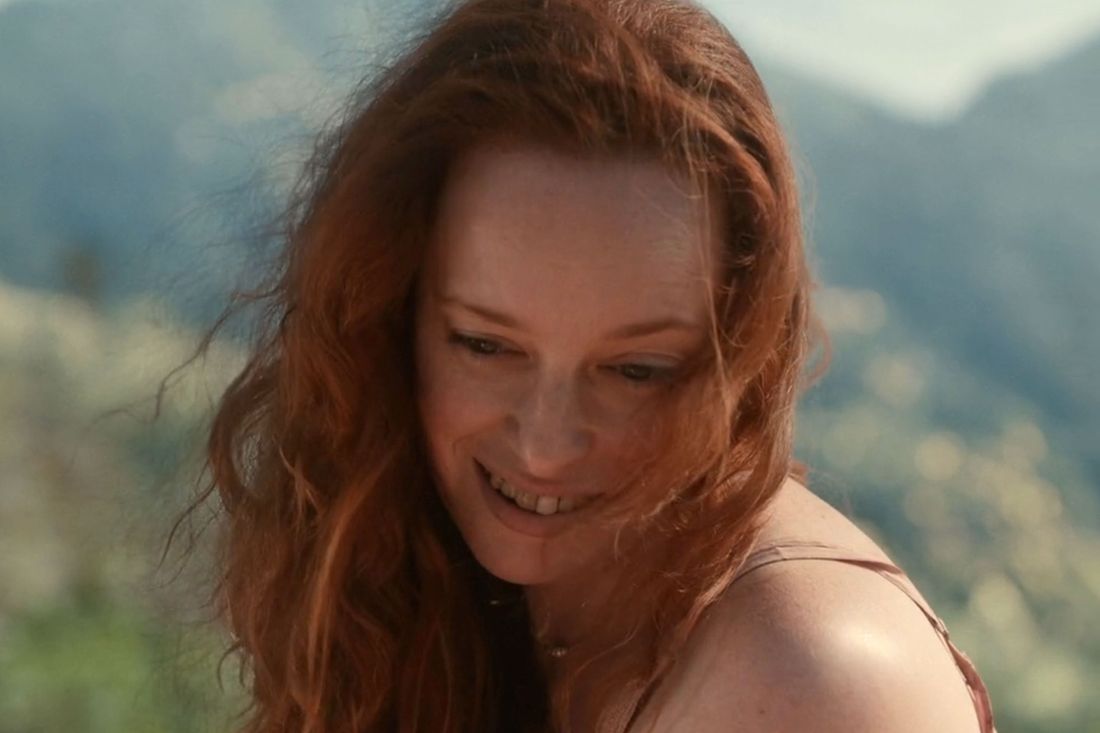
In a different phrasing:
During the application of the veneers, I aimed for a visually appealing yet natural-looking set of teeth, rather than the flawless Hollywood standard. We craft these veneers from dental acrylic and apply lacquer stain to them. All mouth-related items must meet ADA approval. Initially, we designed two distinct looks, with three replicas of each option. She preferred the appearance of the natural-looking teeth, and as a result, opted for veneers that closely matched our creations. Upon her return for season two to have molds made, I complimented the dentist on their excellent work. I later advised the production team about the original design we had created to enhance her smile, comparing it to Valyn’s current teeth. For continuity reasons, they decided not to apply additional veneers over existing ones, as this could result in a bulky appearance and potential discomfort. While extra payment is always tempting, I explained that the current work was already excellent, and further enhancements might not significantly improve its aesthetic appeal.
Austin Powers: International Man of Mystery, Austin Powers: The Spy Who Shagged Me, and Austin Powers in Goldmember
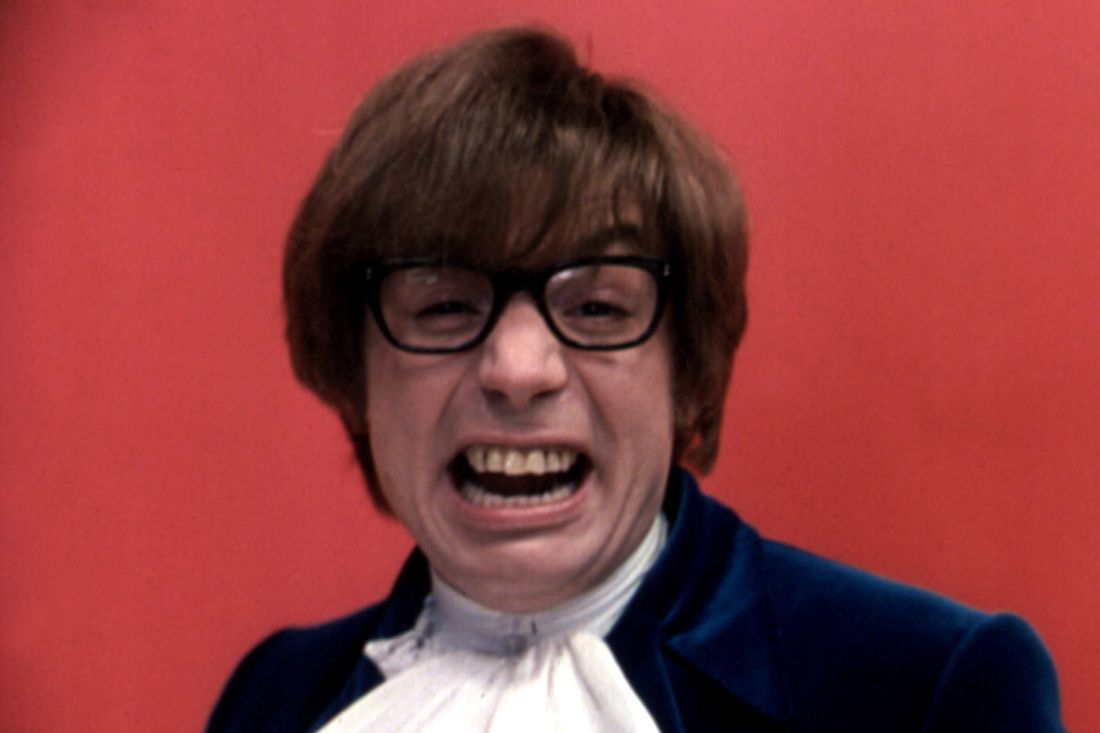
A character becomes iconic when a simple reference like “British spy teeth” instantly triggers a mental image, and Gary Archer acknowledges that Austin Powers will forever be associated with him. Since the release of the 1997 film, he claims that many people have imitated his teeth design, but he also humorously admits being criticized by some who blame him for creating the stereotype of bad British teeth. He further notes that “dodgy teeth” can be found worldwide, but only a handful are as widely recognized as Mike Myers’s Austin Powers character’s mouth.
G.A.: Makeup artist Matthew Mungle reached out to me, stating that he had an actor seeking dental work who would be referred to me. Mike Myers visited my studio, presenting a book showcasing British teeth as his desired look. The comic element involved the use of unsightly 1960s prototype British teeth. Using photos sent by Myers and recalling individuals I’ve met throughout my life, I crafted the teeth using denture acrylic. The initial set of teeth I made were well-received, with Myers exclaiming they were “perfect” upon first try. This project stands out in my memory because there was no need for adjustments or revisions.
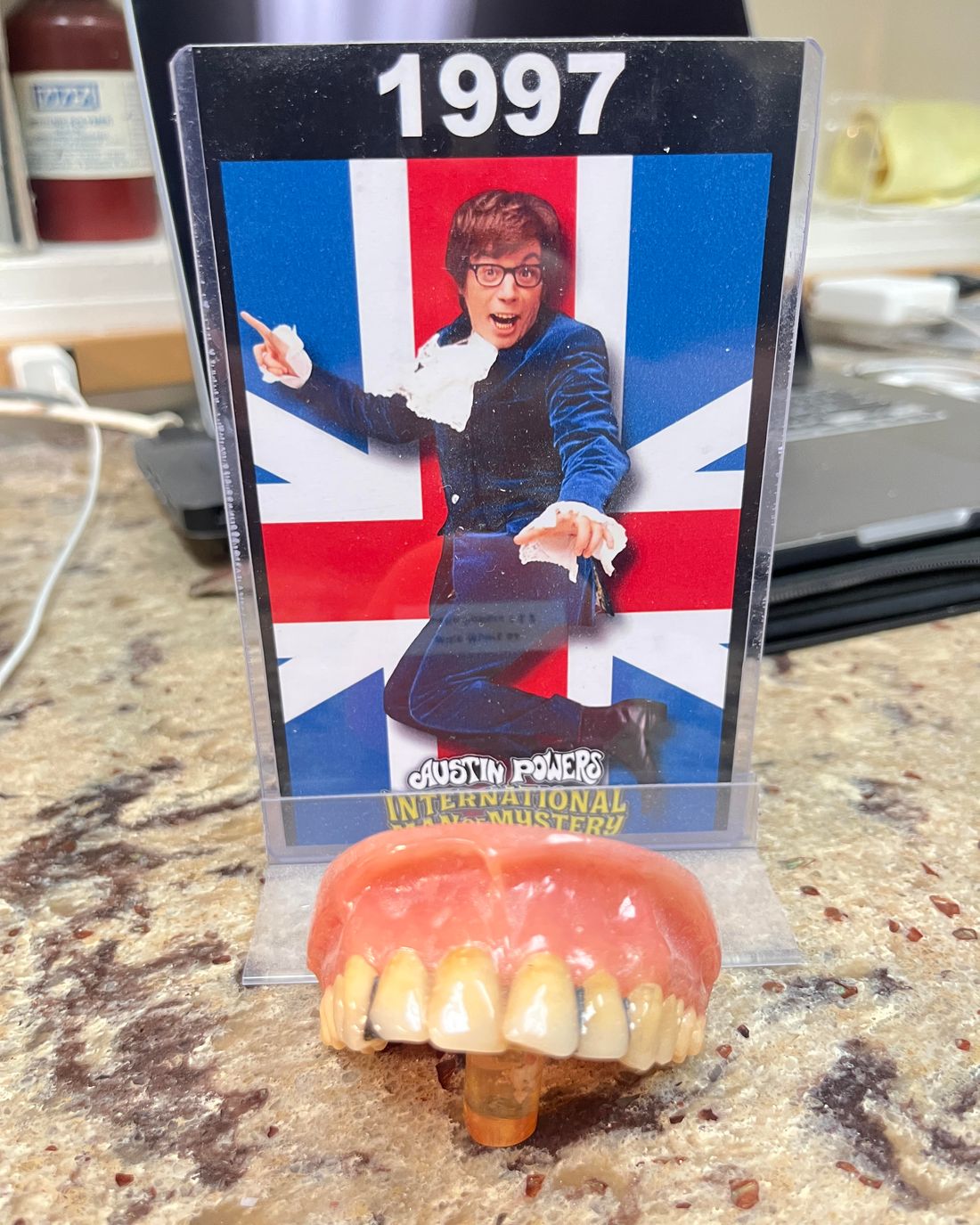
In my portrayal, there were three distinct iterations of the concept – quite poor, very poor, and absolutely awful – and I employed all three throughout the narrative. I frequently toggled between timelines with them. You’ll observe that my teeth are slightly less dense. The edges are smoother, less defined, and they’re not as stark. Nothing was ever discarded. What alters in the sequence is that I undergo dental restoration, but upon returning to the past, I regain my decayed teeth. If you consider Austin Powers without the teeth, it’s simply Mike Myers wearing sunglasses and being humorous. Regrettably, I must emphasize the importance of the teeth, as the character seemed incomplete without them.
We made gold teeth for Verne Troyer and Michael Caine, most notably for the character Goldmember in Austin Powers. If I leave something behind, it will be this iconic role that defines me. I have an original set stored here, and I’ll never part with them – they’re mine forever.
WED clay, named for Walter E. Disney, is an earth clay used for modeling.
Read More
- Hades Tier List: Fans Weigh In on the Best Characters and Their Unconventional Love Lives
- Smash or Pass: Analyzing the Hades Character Tier List Fun
- W PREDICTION. W cryptocurrency
- Why Final Fantasy Fans Crave the Return of Overworlds: A Dive into Nostalgia
- Sim Racing Setup Showcase: Community Reactions and Insights
- Understanding Movement Speed in Valorant: Knife vs. Abilities
- Why Destiny 2 Players Find the Pale Heart Lost Sectors Unenjoyable: A Deep Dive
- PENDLE PREDICTION. PENDLE cryptocurrency
- How to Handle Smurfs in Valorant: A Guide from the Community
- FutureNet Co-Founder Roman Ziemian Arrested in Montenegro Over $21M Theft
2024-10-08 17:56